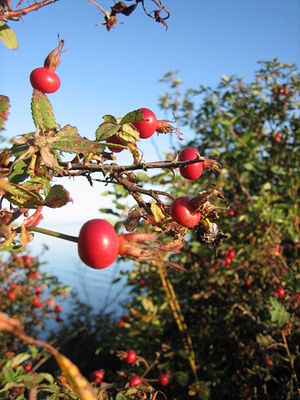When we think about the rose bush, we think of beautiful fragrant flowers that bloom throughout the summer, but the rose bush produces more than just fragrant flowers. Rose bushes also produce a useful fruit, rose hips. Rose hips are vitamin and antioxidant rich, provide visual interest to winter gardens and provide food for birds.
Roses are in the Rosaceae plant family, the same plant family as apples, strawberries, blackberries, peaches, plums and almonds. Rose bushes produce flowers and fruits, just like all the other members of the Rosaceae plant family.
Rose hips appear on rose bushes towards the end of the blooming season. In late summer small green pods form on the ends of the rose bush stems that will turn reddish-orange, yellow or black as they ripen.
Most gardener’s (myself included) were taught to remove rose hips as soon as they appear because they will drain energy from the rose bush for their own development. While this is true, rose hips are valuable in their own right for various uses.
Rose hips are very rich in vitamin C, plus they contain vitamins D & E, contain essential fatty acids and rose hips from certain varieties of rose bushes, like the dog rose, contain more antioxidants than other berries. Many vitamin and herbal supplements contain rose hips. Rose hips are also used to make tea, jam, jelly, pies, oil and bread.
Not only are rose hips good for human consumption, they provide colorful interest to the rose bushes during winter after all the roses and leaves are gone from the rose bush. Birds are also the grateful recipients of rose hips as food during the late fall and winter months.
As I stated earlier, rose hips do drain energy from the rose bush to develop and ripen. A balance between growing spectacular roses on healthy rose bushes can easily be achieved.
Only allowing a few rose hips to develop and ripen per rose bush is one way to strike the balance. If you have several rose bushes as I do, you can allow the rose hips to develop and ripen on alternating rose bushes each year. That allows for the rose bushes to re-coup whatever late season energy that was expended in ripening the rose hips. Or you can just plant the rose bush varieties that produce the most vibrant and useful rose hips and grow them more for the rose hips than for the roses.
The rose bushes that produce the most vibrant rose hips are the common dog rose (Rosa canina) which produce long vase-shaped rose hips. The Rugosas which produce rose hips the size of cherry tomatoes or the spiny chestnut rose (R. roxburghii) which produce black rose hips. These three rose bush varieties produce lovely roses and an abundance of rose hips, which add dramatic landscape color and texture to the winter garden, all contain the vitamins and antioxidants and the birds love the fruit of the rose bush.
Source:
http://en.wikipedia.org/wiki/Rose_hips



